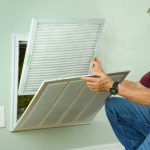
3 Ways to Keep Your Home Comfortable During Seasonal Changes
With the changing of the seasons comes those in-between days of wildly varying temperatures, and it can be difficult to make sure your home is not too hot, not too cold, but just right. Here’s a guide to keeping your home comfortable without confusing your home comfort system.
THERMOSTAT
The U.S. Department of Energy recommends that you keep your thermostat at 68 degrees in the winter and 78 degrees in the summer. Programming your thermostat to these upper and lower limits will ensure that your home doesn’t get too cold at night or too warm during the day and stays within that 10-degree comfort zone. Maintaining a consistent temperature in your house is key to keeping your home comfortable and saving money on your utility bill.
On colder nights, it’s recommended that you lower the thermostat while you’re asleep, and that you allow your house to get a little warmer when you’re not home during warmer days. This is an especially easy adjustment to make if you can program your thermostat to turn your A/C unit on or off at certain times of the day, or if you have a WiFi thermostat you can operate remotely.
Whatever compromise you strike, be sure you don’t adjust your thermostat too much; causing the system to constantly turn on and off more times than it should reduces efficiency.
CEILING FANS
Did you know that your ceiling fans are constructed to rotate both clockwise and counterclockwise? The counterclockwise function is probably your fan’s default—it’s the setting that provides a cooling effect by circulating air downward. The clockwise function is best used during winter. Having your fan rotate clockwise (at a low speed) draws the chillier room air up toward the ceiling, displacing the warm air there and pushing it back down into the room. Because the fan is drawing air up instead of pushing it down, the wind-chill effect utilized during the summer months is negated.
To keep you cool during the day and warm during the night, be sure to switch your fan’s setting depending on the time of day. You can find this switch near the motor on most fans.
INSULATION
It’s not a quick fix, but ensuring that your home is properly insulated is the best way to keep cold air outside and warm air inside (and vice versa.) Good insulation helps keep the temperature inside your home stable, even when the temperature outside isn’t.
While replacing or adding to your wall, attic or floor insulation may be a larger project than you’re willing to take on, there are other steps you can take to improve your home’s insulation. The U.S. Department of Energy reports that windows can account for as much as 25 to 40 percent of a home’s heating and cooling costs. One solution to this problem is to install double-paned windows. As the name suggests, these windows have two panes of glass (separated by a vacuum or gas-filled space) that reduce heat transfer into and out of your home.
Another way to insulate your windows is by utilizing thermal curtains. Thermal curtains are made of double- or triple-layered insulated fabric and are particularly useful during those few transitional weeks of hot days and cold nights. Thermal curtains help keep your home cool during the day by blocking out heat from the sun and preventing cool air from escaping through your windows. They also help keep your home warm at night by preventing warm air from seeping out through the windows.
For more information on how to ensure your home comfort system is running efficiently, contact Barineau Heating & Air Conditioning or give us a call at (850) 580-4029.




